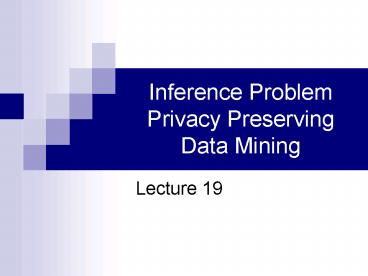Inference Problem Privacy Preserving Data Mining PowerPoint PPT Presentation
1 / 29
Title: Inference Problem Privacy Preserving Data Mining
1
Inference ProblemPrivacy Preserving Data Mining
- Lecture 19
2
Readings and Assignments
- I. Moskowitz, M. H. Kang Covert Channels Here
to Stay? http//citeseer.nj.nec.com/cache/papers/c
s/1340/httpzSzzSzwww.itd.nrl.navy.milzSzITDzSz554
0zSzpublicationszSzCHACSzSz1994zSz1994moskowitz-co
mpass.pdf/moskowitz94covert.pdf - Jajodia, Meadows Inference Problems in
Multilevel Secure Database Management Systems
http//www.acsac.org/secshelf/book001/book001.html
, essay 24
3
Indirect Information Flow Channels
- Covert channels
- Inference channels
4
Communication Channels
- Overt Channel designed into a system and
documented in the user's manual - Covert Channel not documented. Covert channels
may be deliberately inserted into a system, but
most such channels are accidents of the system
design.
5
Covert Channel
- Timing Channel based on system times
- Storage channels not time related communication
- Can be turned into each other
6
Inference Channels
- Non-sensitive
- information
Sensitive Information
Meta-data
7
Inference Channels
- Statistical Database Inferences
- General Purpose Database Inferences
8
Statistical Databases
- Goal provide aggregate information about groups
of individuals - E.g., average grade point of students
- Security risk specific information about a
particular individual - E.g., grade point of student John Smith
- Meta-data
- Working knowledge about the attributes
- Supplementary knowledge (not stored in database)
9
Types of Statistics
- Macro-statistics collections of related
statistics presented in 2-dimensional tables - Micro-statistics Individual data records used
for statistics after identifying information is
removed
10
Statistical Compromise
- Exact compromise find exact value of an
attribute of an individual (e.g., John Smiths
GPA is 3.8) - Partial compromise find an estimate of an
attribute value corresponding to an individual
(e.g., John Smiths GPA is between 3.5 and 4.0)
11
Methods of Attacks and Protection
- Small/Large Query Set Attack
- C characteristic formula that identifies groups
of individuals - If C identifies a single individual I, e.g.,
count(C) 1 - Find out existence of property
- If count(C and D)1 means I has property D
- If count(C and D)0 means I does not have D
- OR
- Find value of property
- Sum(C, D), gives value of D
12
- Protection from small/large query set attack
query-set-size control - A query q(C) is permitted only if
- N-n ? C ? n , where n ? 0 is a parameter of
the database and N is all the records in the
database
13
Tracker attack
q(C) is disallowed
CC1 and C2 TC1 and C2
Tracker
C
C2
C1
q(C)q(C1) q(T)
14
Tracker attack
q(C and D) is disallowed
CC1 and C2 TC1 and C2
C
Tracker
C2
C1
C and D
q(C and D) q(T or C and D) q(T)
D
15
Query overlap attack
Q(John)q(C1)-q(C2)
C1
C2
Kathy
Paul
John
Eve
Max
Fred
Mitch
Protection query-overlap control
16
Insertion/Deletion Attack
- Observing changes overtime
- q1q(C)
- insert(i)
- q2q(C)
- q(i)q2-q1
- Protection insertion/deletion performed as pairs
17
Statistical Inference Theory
- Give unlimited number of statistics and correct
statistical answers, all statistical databases
can be compromised (Ullman)
18
Inferences in General-Purpose Databases
- Queries based on sensitive data
- Inference via database constraints
- Inferences via updates
19
Queries based on sensitive data
- Sensitive information is used in selection
condition but not returned to the user. - Example Salary secret, Name public
- ?Name?Salary25,000
- Protection apply query of database views at
different security levels
20
Database Constraints
- Integrity constraints
- Database dependencies
- Key integrity
21
Integrity Constraints
- CAB
- Apublic, Cpublic, and Bsecret
- B can be calculated from A and C, i.e., secret
information can be calculated from public data
22
Database Dependencies
- Metadata
- Functional dependencies
- Multi-valued dependencies
- Join dependencies
- etc.
23
Functional Dependency
- FD A ? B, that is for any two tuples in the
relation, if they have the same value for A, they
must have the same value for B. - Example FD Rank ? Salary
- Secret information Name and Salary together
- Query1 Name and Rank
- Query2 Rank and Salary
- Combine answers for query1 and 2 to reveal Name
and Salary together
24
Key integrity
- Every tuple in the relation have a unique key
- Users at different levels, see different versions
of the database - Users might attempt to update data that is not
visible for them
25
Example
Secret View
Public View
26
Updates
Public User
- Update Blacks address to Orlando
- Add new tuple (Red, 22,000, Manassas)
- If
- Refuse update covert channel
- Allow update
- Overwrite high data may be incorrect
- Create new tuple which data it correct
- (polyinstantiation) violate key constraints
27
Updates
Secret user
- Update Blacks salary to 45,000
- If
- Refuse update denial of service
- Allow update
- Overwrite low data covert channel
- Create new tuple which data it correct
- (polyinstantiation) violate key constraints
28
Inference Problem
- No general technique is available to solve the
problem - Need assurance of protection
- Hard to incorporate outside knowledge
29
Next Class
- Firewalls

